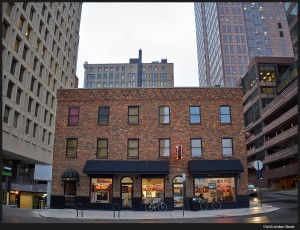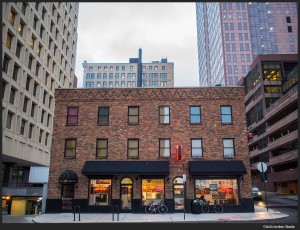Image Quality: Sharpness and color

The Olympus 17mm f/1.8 is a sharp lens, but not a brilliant lens. It seems to perform its best at close to medium focus distances, in the range where you’d be doing environmental portraiture or the like. Here, I find the lens gives a great rendering with good sharpness at the focus point throughout the majority of the frame, right from wide open. At greater focus distances and landscape type work, it’s good, but not great. Center sharpness is good, but even stopped down, there is some softening at the edges. It’s not bad, but I’ve seen better.
At closest focus, it also suffers from some softness at wider apertures. It really seems that Olympus focused on optimizing the lens for ‘street’ shooting, and for that range, it’s really a great lens when coupled with the fast autofocus.
The Olympus 17mm f/1.8 renders scenes in a pretty neutral way, with good contrast and natural color. There’s no big ‘pop’, but it lends itself well to environmental portrait work due to even skin tone rendering and neutral color palette.
Bokeh
As can be seen in the image above, bokeh on the 17mm f/1.8 is pretty nice. Specular highlights are neutral with only the slightest hint of a ring, and the general rendering is smooth and pleasing. This is the case on closer shots such as that photo.
However, when shooting more distant subjects, the bokeh changes considerably, mainly due to the presence of some longitudinal chromatic aberration. Due to the wider focal length, shots taken at wide apertures at longer distances really don’t show a lot of blur, and when backgrounds are busy, this results in a very nervous appearance to the bokeh. It can be a little distracting. See the image below for an example:

Chromatic Aberration, Flare and Distortion
The Olympus 17mm f/1.8 performs OK with regards to chromatic aberration. There is visible lateral CA at all apertures, though nowhere near the level of its slower f/2.8 sibling. Luckily, this can be easily corrected with software without much trouble. As noted above, there can be some longitudinal CA as well, though it’s really only distracting in certain cases, such as the shot above. For most work, especially at closer ranges, it isn’t an issue.
I didn’t have an opportunity to test flare with regards to direct sunlight, since in the week I had the lens for review, we literally had zero visible sunlight in central Ohio for the entirety of that week. I did not notice any visible flaring with natural light sources, and it seemed to control flare quite well in everyday use.
Distortion on JPEGs or with RAW converters such as Lightroom/ACR that read the lens distortion metadata is very low. However, there is a lot of camera/converter correction being applied, which may account for some of the softer corners. When using a RAW converter such as Capture One Pro 7, that doesn’t read the distortion correction metadata, distortion is outrageously high, though corner resolution is improved. See the two images below. These are the same image, converted from the same RAW file. The Capture One Pro conversion (without distortion correction) is on the left, while the Lightroom conversion (with correction) is on the right. Wow.







Leave a Reply